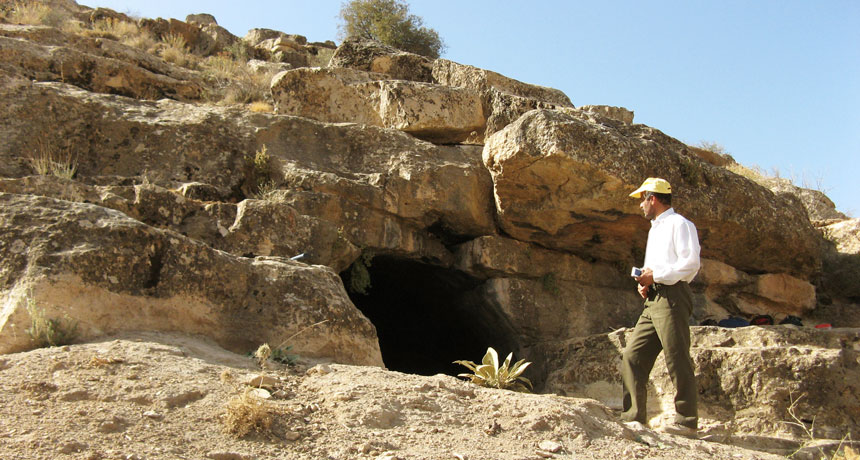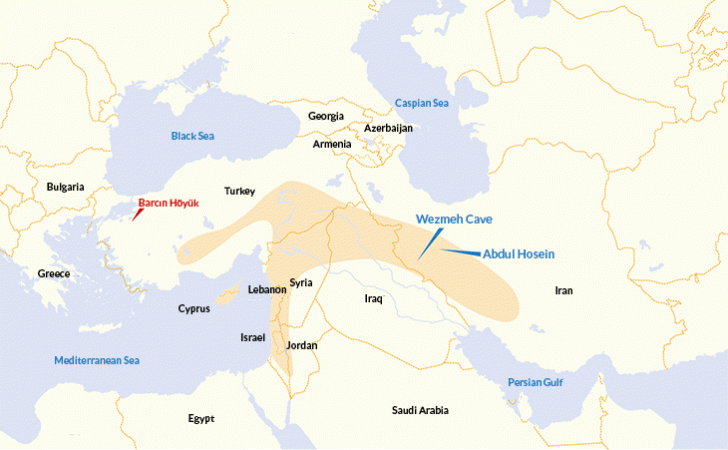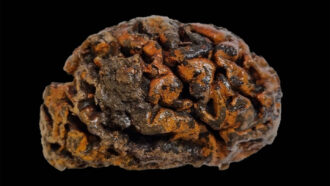The first farmers were two groups, not one
The ancient cultures moved apart to take farming east and west

A bone fragment from a 7,000-year-old farmer was discovered in this cave in Iran. His DNA, and the DNA of three other individuals from a second Iranian site, revealed that there were two different groups of early farmers.
FEREIDOUN BIGLARI
Humans first learned to farm about 10,000 years ago in an area called the Fertile Crescent. It included parts of the Middle East and the Mediterranean with good growing conditions. Here, ancient humans began keeping animals and tending crops. A new study finds that these first farmers were really two societies living side-by-side. And that was a big surprise. Over time, one group appears to have expanded west, carrying agriculture into Europe. The other spread east, taking their traditions into South Asia.
Researchers shared their unexpected results online July 14 in Science.
“We thought the people of the Fertile Crescent were one group genetically and culturally, but in fact they were probably two or more,” says Joachim Burger. He studies ancient genetics at Johannes Gutenberg University Mainz in Germany. Burger also led the new study. Textbooks tell us that modern Europeans and South Asians descended from a single ancient people. But it’s time to rethink that idea, Burger now concludes.
Earlier this year, his team found that the first European farmers came from a region called western Anatolia. They lived near what’s now Istanbul, Turkey. The researchers reported the finding in the Proceedings of the National Academy of Sciences. They suspected these Anatolians had started out living farther east. Maybe they’d lived at older sites in what’s now Iran, Iraq, Syria and southeastern Turkey.
But new evidence from two ancient Iranian sites tells a different story. It comes from the remains of humans who lived 7,000 to 10,000 years ago. By analyzing the ratios of carbon and nitrogen in the bones, scientists now show that these people ate more farmed grains than meat. That means they were farmers. And they lived several thousand years before the Anatolians. And DNA analyses show that these Iranians and Anatolians were not closely related.

In fact, the two groups had probably separated more than 45,000 years earlier, says Garrett Hellenthal. He’s a statistical geneticist at University College London and coauthor of the new study. That would mean the groups split just after ancient humans left Africa. Even 10,000 years ago, the ancestors of Iranians and Anatolians had already been living apart for 36,000 to 67,000 years, according to their DNA.
Evidence of the Anatolian farmers is a few thousand years younger than the Iranian remains. But the cultures “must have known each other to some extent,” Burger says.
People in the two groups probably looked different and spoke separate languages, Burger says. They didn’t have children together. But they must have shared the ideas of early agriculture. It would have taken centuries for each group to switch from hunting and gathering to farming.
“Domestication of wild beasts is nothing you do over the weekend,” Burger says. And it would be too much of a coincidence for two groups to “invent something crazy and complicated like farming” at the same time.
But not everyone shares his view. “The change from hunting to farming happened probably several times,” says Roger Matthews. He’s an archaeologist at the University of Reading in England who was not involved in the new research. Even though both the Anatolians and Iranians were farmers, he says, “it’s not actually the same idea they’re coming up with.” In the East, early farmers focused on goats as well as barley and wheat. But in the West, shepherds raised sheep and other foods. Matthews thinks the two communities took their first steps toward farming separately.
Sometime after farming developed, the two cultures began to move apart physically too. Why they spread so differently is still a mystery. To prove that one group spread eastward from Iran, scientists will need more DNA samples from ancient people east of the Fertile Crescent, says Christina Papageorgopoulou. She’s an anthropologist at the Democritus University of Thrace in Greece. She worked on the Anatolian study but not the newer research.
More DNA from the Fertile Crescent might reveal why the Iranians and Anatolians stayed apart. Maybe there was a border or boundary between the two ancient groups. “I cannot imagine there was a connection,” Papageorgopoulou says. If there were, scientists would see have seen it in the DNA. “I think there is some kind of barrier there,” she says.
Right now scientists can study the DNA evidence on a large scale and say that the two groups of early farmers weren’t related. But more DNA evidence would let them zoom in to look at villages, or even households. Then they could “come closer to ancient humans and how they lived,” Burger says. He hopes to analyze whole Stone Age villages and piece together ancient family trees. That would help scientists really understand who migrated where.







